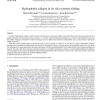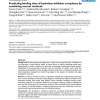146 search results - page 23 / 30 » Evolutionary design of the energy function for protein struc... |
CANDC
2006
ACM
13 years 7 months ago
2006
ACM
A model of hydrophobic collapse, which is treated as the driving force for protein folding, is presented. This model is the superposition of three models commonly used in protein ...
BIRD
2008
Springer
13 years 9 months ago
2008
Springer
The inverse protein folding problem is that of designing an amino acid sequence which has a prescribed native protein fold. This problem arises in drug design where a particular st...
RECOMB
2005
Springer
14 years 7 months ago
2005
Springer
We present a novel computational method, MultiBind, for recognition of binding patterns common to a set of protein structures. It is the first method which performs a multiple alig...
BMCBI
2004
13 years 7 months ago
2004
Background: Protein-protein interactions play a critical role in protein function. Completion of many genomes is being followed rapidly by major efforts to identify interacting pr...
GECCO
2007
Springer
14 years 1 months ago
2007
Springer
The protein folding problem consists of predicting the functional (native) structure of the protein given its linear sequence of amino acids. Despite extensive progress made in un...


